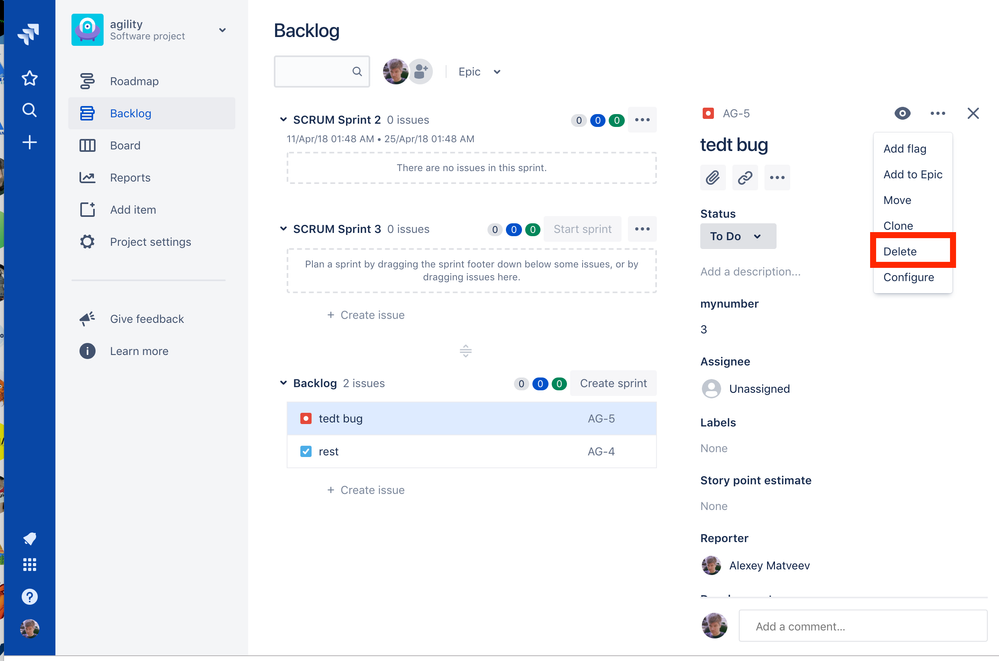I am old school. Back in the day, logging a ticket was not everybody’s job. Prioritizing and removing tickets from the queue was also handled by a coveted few. Limitations on data (storage) also contributed to further bottle neck ticket creation, prioritization and maintenance. Every ticket was precious.
Then came agile and coincidentally data (storage data) also became bigger and cheaper. Everyone was allowed to log a ticket for ideas, issues, needs and wants. No topic was taboo (as long as it was within the scope of a project of course)
Tickets gave an opportunity for every team member to use their voice. And this WAS very important in Agile, people over processes. I say WAS because since last 4 years I have seen a trend of deleting tickets for the silliest of reasons in the name of Agile and keeping the backlog lean!! Not just at one company or team but in multiple teams. I also happen to observe that the people who do this are new to IT.
 |
Some of the justifications I heard were –
1. Duplicate (but they do not even take time to compare the alleged duplicate tickets side by side)
2. Not Relevant anymore (even when there is history in the ticket)
3. Not a real issue (even when there is history in the ticket)
4. Not Reproducible Issue
5. We can’t fix this Issue
6. Requirement from the previous team member
7. It is an old issue
8. Placeholder tickets

What could you do instead of deleting a ticket?
1. Duplicate
a. Compare the tickets side by side. Make sure they are duplicates
b. Link tickets as duplicate
c. Pick the ticket with the most detail to work on
d. The other ticket – Close it and assign it back to the Owner mentioning the duplicate ticket with the link to the duplicate ticket.
e. This gives the owner of the ticket information that the issue is being taken care of. And they may learn from the chosen ticket as to what the Product Owner looks for as far as details go.
2. Not Relevant anymore
a. Make sure it is absolutely not relevant.
b. Comment about why it is not relevant
i. The direction of the product changed, and the old ideas are no longer relevant
ii. The idea is good, but it is not product or project related
c. Assign it back to the Owner, and give them learn about the outcome
d. Close or keep the ticket open. But assign another status Not relevant anymore
3. Not a real issue
a. Comment about why
i. It is not an issue but a feature
ii. Link a test case or a story
b. Assign it back to the Owner
c. Close it
d. Assign status Rejected / Working as intended
4. Not Reproducible
a. Comment that is it not reproducible
b. Talk to the developers if the information in the ticket suffices, if not what other information is needed might help to resolve the sporadic issue.
c. Assign it back to the Owner
d. Assign status Not Reproducible
5. We can’t fix this Issue
a. Comment that this is legit issue, but it cannot be resolved
b. Comment about why it cannot be resolved
i. Too minor to address and it could break other things.
ii. Business decided, since no one complained about this issue and it is minor, we will let it go.
iii. It is an edge case and won’t happen again
c. Assign it back to the Owner
d. Close the ticket
e. Assign status Won’t Fix
6. An old issue
a. If it is still reproducible
i. Comment confirming the issue and move on
b. Do not close it
c. Do not remove it from the backlog
7. Requirement from the previous team member
a. If you do not understand it well, but if it has some or ample information
b. Leave it in the backlog
c. OR if there are too many issues like this
d. Create a dummy project
e. Move all the tickets into the dummy project
8. Placeholder tickets
a. No information is available, it has been over a week or more since they were logged
b. It is nice to respect peoples time to log ticket and update it, but a week is enough.
c. DELETE These without any guilt!!
d. Plus make it part of your team agreement to delete lazy tickets.
What can a ticket teach you?
If we look closely, every ticket is a learning opportunity about the team, the person, the thought process.
Incident 1
Once on a project there were high number of duplicates. After filtering tickets with duplicates, it came to attention that one team member created a majority of duplicates. Upon closer inspection at created by and crated when, it was very apparent that the new team member was logging similar tickets within 20 to 60 mins after an original Bug was logged. If the tickets from the new team member were of superior quality, that would have been an improvement, they were not, they were straight up copy pastes in some tickets. So, basically the new team member was faking work.
If we were delete, delete, deleting duplicates we would have missed out on a fun revelation.
Incident 2
I was given a project that had a bunch of already completed and to be worked on tickets (in hundreds). The same project also has at least a 100 of the current product’s tickets that were very relevant to me and my team. It was a pain in the neck to separate the shutdown products tickets from the new ones. I knew it would be a bigger issue once time for release came and assigning Fix version.
I was also OCD for keeping only the tickets for my product in the project and showing correct numbers. But I am old school, so I created a new project and moved all the old tickets to the new project retaining all the information and artifacts the tickets had. About 8 months down the Business Analysist who wrote a majority of the tickets wanted some information from his old tickets and looked in the project (he still had access to the project). He did not find his tickets and assumed they were deleted. He was sad and frustrated.
He expressed his frustration, I immediately understood who he was and gave him access to the other project where I moved the tickets to. Within hours he and his manager wrote a nice email mentioning that they would not have blamed me if I deleted the tickets, but they thank me for respecting their work and keeping it safe.
They were able to take some of their ideas and documentation which saved them 2 sprints worth of work, which is nothing to sneeze about.
Incident 3
QA logs bug. The bug is deleted. Then other team members accuse the QA of missing a bug / slacking at work. This is one main reason many QA members hate the practice of deleting any ticket. They lose traceability to their work. This did not happen to me fortunately. But it did happen to a whole team of testers in India, when their tickets were deleted. They had to retest everything all over again. No, the project did not get delayed, these days the team is expected to work overtime.

Backing up before deleting a ticket is slightly better, but it does not give visibility to all.
Irrelevant tickets can also be separated by resolution status or a fix version and many more options. Look into options and talk to your peers.
Tickets take minutes, hours and even days to get it to perfection. Deleting this ticket without offering the owner an answer, traceability and especially an opportunity to learn, is saying YOU (human) are not important. It is demoralizing and creates an environment that cannot be trusted.



